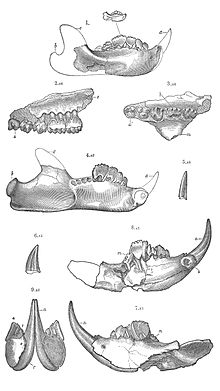| Ctenacodon Temporal range: Late Jurassic | |
|---|---|
 | |
| Lower and upper jaws | |
| Scientific classification | |
| Domain: | Eukaryota |
| Kingdom: | Animalia |
| Phylum: | Chordata |
| Class: | Mammalia |
| Order: | † Multituberculata |
| Family: | † Allodontidae |
| Genus: | † Ctenacodon Marsh, 1879 |
| Species | |
| |
Ctenacodon is a genus of extinct mammal that lived in what is now North America during the Upper Jurassic period. It is a member of the family Allodontidae within the order Multituberculata. Ctenacodon, also known as Allodon (Marsh 1881), was named by Othniel Charles Marsh in 1879. At least three species are currently recognized.
Present in stratigraphic zone 5. [1] Remains possibly referrable to Ctenacodon have been recovered from stratigraphic zone 2. [1]


